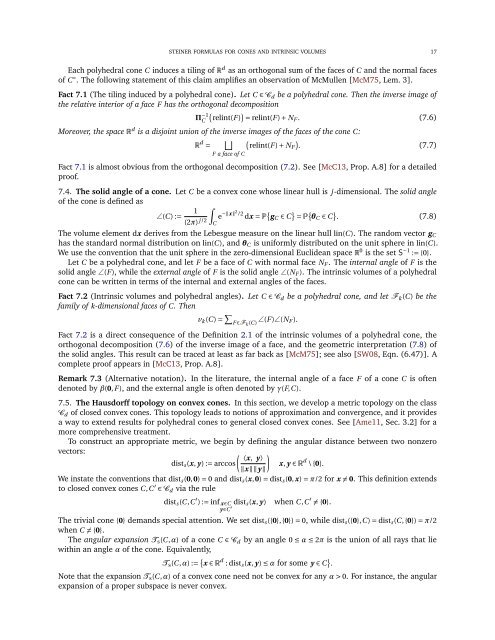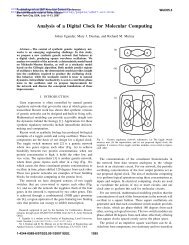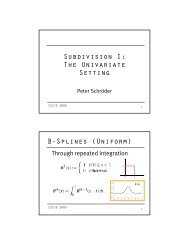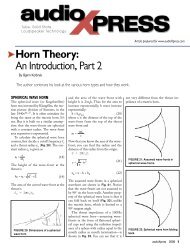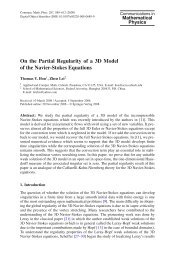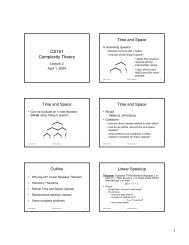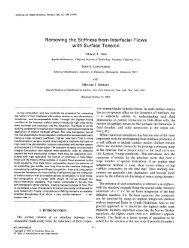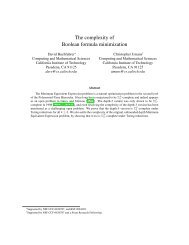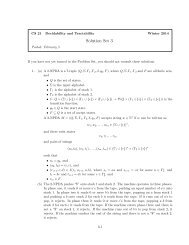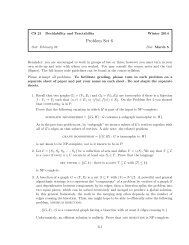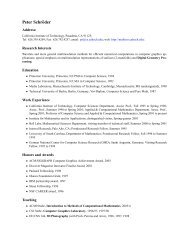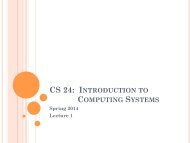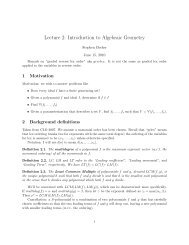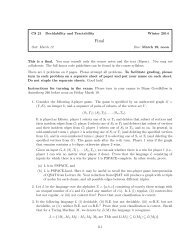From Steiner formulas for cones to concentration of intrinsic volumes
From Steiner formulas for cones to concentration of intrinsic volumes
From Steiner formulas for cones to concentration of intrinsic volumes
Create successful ePaper yourself
Turn your PDF publications into a flip-book with our unique Google optimized e-Paper software.
STEINER FORMULAS FOR CONES AND INTRINSIC VOLUMES 17Each polyhedral cone C induces a tiling <strong>of</strong> R d as an orthogonal sum <strong>of</strong> the faces <strong>of</strong> C and the normal faces<strong>of</strong> C ◦ . The following statement <strong>of</strong> this claim amplifies an observation <strong>of</strong> McMullen [McM75, Lem. 3].Fact 7.1 (The tiling induced by a polyhedral cone). Let C ∈ C d be a polyhedral cone. Then the inverse image <strong>of</strong>the relative interior <strong>of</strong> a face F has the orthogonal decomposition( )relint(F ) = relint(F ) + NF . (7.6)Π −1CMoreover, the space R d is a disjoint union <strong>of</strong> the inverse images <strong>of</strong> the faces <strong>of</strong> the cone C:R d ⊔ ( )=relint(F ) + NF . (7.7)F a face <strong>of</strong> CFact 7.1 is almost obvious from the orthogonal decomposition (7.2). See [McC13, Prop. A.8] <strong>for</strong> a detailedpro<strong>of</strong>.7.4. The solid angle <strong>of</strong> a cone. Let C be a convex cone whose linear hull is j-dimensional. The solid angle<strong>of</strong> the cone is defined as1∠(C) := e −‖x‖2 /2 dx = P { g C ∈ C } = P { θ C ∈ C } . (7.8)(2π) j /2 ∫CThe volume element dx derives from the Lebesgue measure on the linear hull lin(C). The random vec<strong>to</strong>r g Chas the standard normal distribution on lin(C), and θ C is uni<strong>for</strong>mly distributed on the unit sphere in lin(C).We use the convention that the unit sphere in the zero-dimensional Euclidean space R 0 is the set S −1 := {0}.Let C be a polyhedral cone, and let F be a face <strong>of</strong> C with normal face N F . The internal angle <strong>of</strong> F is thesolid angle ∠(F ), while the external angle <strong>of</strong> F is the solid angle ∠(N F ). The <strong>intrinsic</strong> <strong>volumes</strong> <strong>of</strong> a polyhedralcone can be written in terms <strong>of</strong> the internal and external angles <strong>of</strong> the faces.Fact 7.2 (Intrinsic <strong>volumes</strong> and polyhedral angles). Let C ∈ C d be a polyhedral cone, and let F k (C) be thefamily <strong>of</strong> k-dimensional faces <strong>of</strong> C. Thenv k (C) = ∑ F ∈F k (C) ∠(F )∠(N F ).Fact 7.2 is a direct consequence <strong>of</strong> the Definition 2.1 <strong>of</strong> the <strong>intrinsic</strong> <strong>volumes</strong> <strong>of</strong> a polyhedral cone, theorthogonal decomposition (7.6) <strong>of</strong> the inverse image <strong>of</strong> a face, and the geometric interpretation (7.8) <strong>of</strong>the solid angles. This result can be traced at least as far back as [McM75]; see also [SW08, Eqn. (6.47)]. Acomplete pro<strong>of</strong> appears in [McC13, Prop. A.8].Remark 7.3 (Alternative notation). In the literature, the internal angle <strong>of</strong> a face F <strong>of</strong> a cone C is <strong>of</strong>tendenoted by β(0,F ), and the external angle is <strong>of</strong>ten denoted by γ(F,C).7.5. The Hausdorff <strong>to</strong>pology on convex <strong>cones</strong>. In this section, we develop a metric <strong>to</strong>pology on the classC d <strong>of</strong> closed convex <strong>cones</strong>. This <strong>to</strong>pology leads <strong>to</strong> notions <strong>of</strong> approximation and convergence, and it providesa way <strong>to</strong> extend results <strong>for</strong> polyhedral <strong>cones</strong> <strong>to</strong> general closed convex <strong>cones</strong>. See [Ame11, Sec. 3.2] <strong>for</strong> amore comprehensive treatment.To construct an appropriate metric, we begin by defining the angular distance between two nonzerovec<strong>to</strong>rs:( ) 〈x, y〉dist s (x, y) := arccosx, y ∈ R d \ {0}.‖x‖‖y‖We instate the conventions that dist s (0,0) = 0 and dist s (x,0) = dist s (0, x) = π/2 <strong>for</strong> x ≠ 0. This definition extends<strong>to</strong> closed convex <strong>cones</strong> C,C ′ ∈ C d via the ruledist s (C,C ′ ) := inf x∈Cy∈C ′ dist s (x, y) when C,C ′ ≠ {0}.The trivial cone {0} demands special attention. We set dist s ({0},{0}) = 0, while dist s ({0},C) = dist s (C,{0}) = π/2when C ≠ {0}.The angular expansion T s (C,α) <strong>of</strong> a cone C ∈ C d by an angle 0 ≤ α ≤ 2π is the union <strong>of</strong> all rays that liewithin an angle α <strong>of</strong> the cone. Equivalently,T s (C,α) := { x ∈ R d : dist s (x, y) ≤ α <strong>for</strong> some y ∈ C } .Note that the expansion T s (C,α) <strong>of</strong> a convex cone need not be convex <strong>for</strong> any α > 0. For instance, the angularexpansion <strong>of</strong> a proper subspace is never convex.


